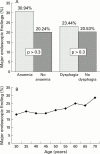Age and alarm symptoms do not predict endoscopic findings among patients with dyspepsia: a multicentre database study
- PMID: 11413107
- PMCID: PMC1728370
- DOI: 10.1136/gut.49.1.29
Age and alarm symptoms do not predict endoscopic findings among patients with dyspepsia: a multicentre database study
Abstract
Introduction: Symptoms of dyspepsia are common but most patients do not have major upper gastrointestinal pathology. Endoscopy is recommended for dyspeptic patients over the age of 45, or those with certain "alarm" symptoms. We have evaluated the effectiveness of age and "alarm" symptoms for predicting major endoscopic findings in six practising endoscopy centres.
Methods: Clinical variables of consecutive patients with dyspepsia symptoms undergoing upper endoscopy examinations were recorded using a common endoscopy database. Patients who had no previous upper endoscopy or barium radiography were included. Stepwise multivariate logistic regression was used to identify predictors of endoscopic findings. The accuracy of these for predicting endoscopic findings was evaluated with receiver operating characteristic analysis. The sensitivity and specificity of age thresholds from 30 to 70 years were evaluated.
Results: Major pathology (tumour, ulcer, or stricture) was found at endoscopy in 787/3815 (21%) patients with dyspepsia. Age, male sex, bleeding, and anaemia were found to be significant but weak independent predictors of endoscopic findings. A multivariate prediction rule based on these factors had poor predictive accuracy (c statistic=0.62). Using a simplified prediction rule of age > or =45 years or the presence of any "alarm" symptom, sensitivity was 87% and specificity was 26%. Increasing or decreasing the age cut off did not significantly improve the predictive accuracy.
Conclusions: Age and the presence of "alarm" symptoms are not effective predictors of endoscopic findings among patients with dyspepsia. Better clinical prediction strategies are needed to identify patients with significant upper gastrointestinal pathology.
Figures


Comment in
-
Current guidelines fail young patients with oesophagogastric cancer.Gut. 2002 Aug;51(2):296-7. doi: 10.1136/gut.51.2.296-a. Gut. 2002. PMID: 12117899 Free PMC article. No abstract available.
References
Publication types
MeSH terms
LinkOut - more resources
Full Text Sources
Medical
